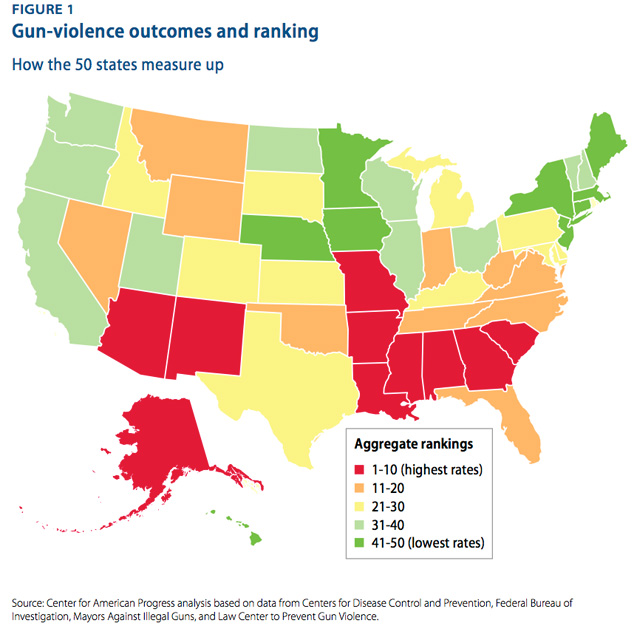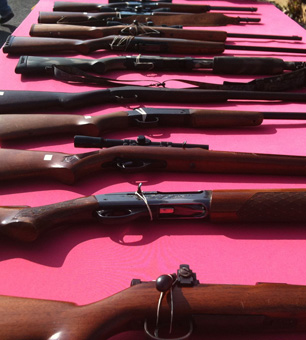In the aftermath of mass shootings and other gun-related tragedies, there is often a surge of interest on the part of community leaders, social-science researchers, and elected officials to root out the causes of gun violence in an effort to prevent such tragedies from occurring again. Any study into the causes of gun violence is necessarily complicated, however, as there are innumerable factors that contribute to the nature and prevalence of gun-related violence in any community.
Despite this complex web of factors that influence the rate of gun violence, this report finds a clear link between high levels of gun violence and weak state gun laws. Across the key indicators of gun violence that we analyzed, the 10 states with the weakest gun laws collectively have an aggregate level of gun violence that is more than twice as high—104 percent higher, in fact—than the 10 states with the strongest gun laws.
The data analyzed in this report relate to the following 10 indicators of gun violence:
- Overall firearm deaths in 2010
- Overall firearm deaths from 2001 through 2010
- Firearm homicides in 2010
- Firearm suicides in 2010
- Firearm homicides among women from 2001 through 2010
- Firearm deaths among children ages 0 to 17, from 2001 through 2010
- Law-enforcement agents feloniously killed with a firearm from 2002 through 2011
- Aggravated assaults with a firearm in 2011
- Crime-gun export rates in 2009
- Percentage of crime guns with a short “time to crime” in 2009
Using these data, we rank each state according to the rate of each indicator of gun violence and create an overall ranking of the states across all 10 indicators, resulting in an overall state ranking for the prevalence of gun violence. Finally, we compare this overall state gun-violence ranking with a Law Center to Prevent Gun Violence ranking of states based on the strength of their gun laws.
Our analysis determined that the following are the 10 states, by rank, that suffer the highest levels of gun violence:
- Louisiana
- Alaska
- Alabama
- Arizona
- Mississippi
- South Carolina
- New Mexico
- Missouri
- Arkansas
- Georgia

The Law Center to Prevent Gun Violence analysis shows that eight of these states are among the 25 states with the weakest gun laws.
While the strength of a state’s gun laws is just one factor in the prevalence of gun-related violence in the state and cannot alone account for gun violence, there is a clear link between weak gun laws and high levels of gun violence across the United States.
Arkadi Gerney is a Senior Fellow at the Center for American Progress. Chelsea Parsons is Associate Director of Crime and Firearms Policy at the Center. Charles Posner is the State Communications Assistant at the Center.
To see each of the top 10 state fact sheets, visit the following links:
See also: Interactive: Measuring Gun Violence Across the 50 States
Endnotes and citations are available in the PDF version of this report.
Our most important fundraising appeal of the year
December is the most critical time of year for Truthout, because our nonprofit news is funded almost entirely by individual donations from readers like you. So before you navigate away, we ask that you take just a second to support Truthout with a tax-deductible donation.
This year is a little different. We are up against a far-reaching, wide-scale attack on press freedom coming from the Trump administration. 2025 was a year of frightening censorship, news industry corporate consolidation, and worsening financial conditions for progressive nonprofits across the board.
We can only resist Trump’s agenda by cultivating a strong base of support. The right-wing mediasphere is funded comfortably by billionaire owners and venture capitalist philanthropists. At Truthout, we have you.
We’ve set an ambitious target for our year-end campaign — a goal of $250,000 to keep up our fight against authoritarianism in 2026. Please take a meaningful action in this fight: make a one-time or monthly donation to Truthout before December 31. If you have the means, please dig deep.
